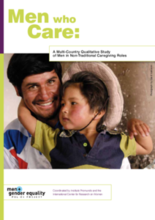The “Men Who Care” report is a five-country (Brazil, Chile, India, Mexico, and South Africa) study that explores the topic of men who are involved in non-traditional forms of care work. These men are described as engaging in care beyond what is traditional amongst their male peers, including men in primary caregiving for children or others at home but also men in paid care work professions where women predominates. The study examines how they view their own work, how they came to be engaged in it, and asks a number of questions about the perceptions around engaging in what some cultures consider ‘female work’. This report presents a summary of each of the five country studies. The topics selected for cross- country analysis include: (1) men’s description of their caregiving activities; (2) men’s household and relationship dynamics; (3) men’s childhood experiences and pathways to caregiving; and (4) men’s attitudes toward gender equality more broadly.
A number of interesting key findings were highlighted: 1) In most cases, men found themselves in non-traditional caring work by life-circumstance (partner illness, death, unemployment) rather than by individual choice; 2) Men who saw their fathers engaged in care work were somewhat more likely to also engage but nearly an equal number of the men interviewed reported that their fathers were not involved in caregiving; 3) the quality of the men’s relationship to their partners (particularly the mothers of their children) greatly affected to what extent they participated in care work; 4) some men tried to emphasize the masculine aspects and downplay the perceived feminine aspects of their work; and 5) men’s satisfaction with their role as non-traditional caregivers was varied.
Some men were involved in caregiving in the household as a long- term practice while others did it short-term in response to specific circumstances. Some men interviewed had been or were primary caregivers in the home in the short-term or for a fixed time, while a partner could pursue her career. Others served as foster parents for a non-relative child for a time and later resumed their “traditional” role as secondary caregivers. Across the settings, many of the men involved in professional care work were also involved in care work at home.
Many of the men expressed feeling a general sense of discontentment in the traditional “male” role. One respondent explained that he felt that men struggled to determine how to fit care into their constructs of masculinity (and construct their masculinity overall), largely because they had to do so in isolation. Despite participating as caregivers in the lives of their children, there were diverse types of contradictions when men spoke about gender equity. Thus, employing gender-equitable behaviors is not necessarily accompanied by a pro-gender equality discourse when it comes to policy. At the same time, the authors conclude that it was impressive that these men construct new ways of being men even as they are inconsistent in terms of how much they fully accept or embrace gender equality. A few men showed a consistent practice and discourse of gender equality, but there were just as many who did the care work but were angry with or mistrusted women, or who maintained unequal practices and sometimes mistreated women.
The report concludes by pointing out that apart from the handful of men who were exposed to gender equality messages via their work with NGOs, most men were not aware of campaigns or policy initiatives or debates about encouraging men to be involved in caregiving. None of the men mentioned having seen campaigns on fatherhood. It calls for, among other things, enhanced initiatives to change norms and rules in workplaces and other social services spaces (hospitals, schools, daycare centers and the like) related to men’s and women’s multiple roles as providers and caregivers.

